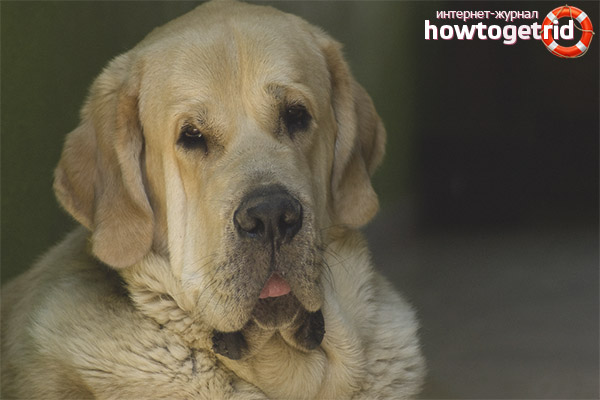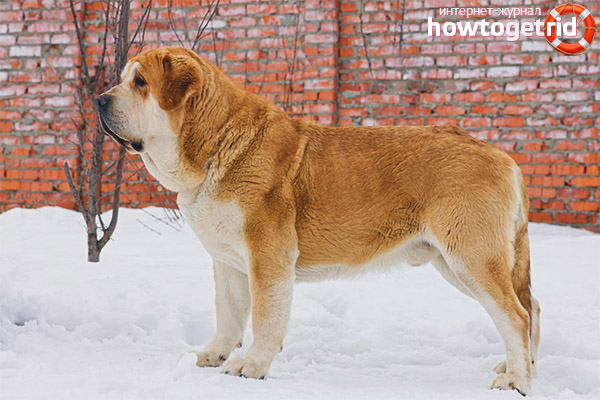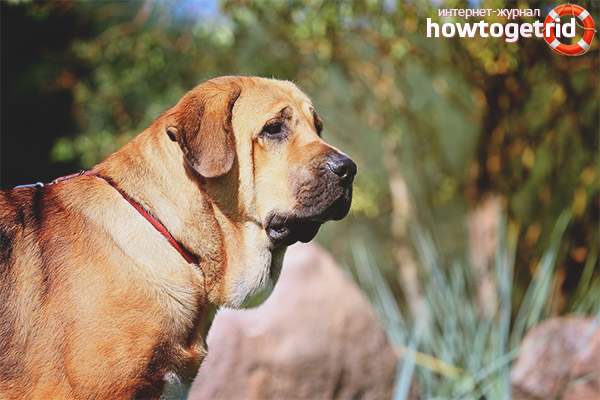The content of the article
At first glance, such a pet seems simply huge and very serious. He is not associated with the best friend of children and family favorite. This is exactly the case when the first impression is deceptive. For many centuries in a row, Spanish mastiffs have been human assistants in housekeeping - we are talking about grazing and protecting the house. In addition, they are not inclined to show aggression to weaker animals.
From the history of the breed
Many years ago, when people still lived in groups and received the gifts of nature for basic livelihoods by means of extraction and the most primitive skills of farming and cattle breeding, they noticed somewhere nearby animals that looked like wolves, but were not aggressive. They needed help in protecting their herds from predators, and distant wolf relatives did an excellent job of this. In addition, they helped protect the land and possessions from the encroachment of strangers.
People called new friends who have already become indispensable helpers in the household, mastiffs. Groups of people began to communicate with each other and exchange experience in cattle breeding and farming. Each group had its own different dogs, helping with the housework. In order to improve the pedigree qualities of pets, they were crossed among themselves.
The inhabitants of Spain set themselves the task - to get an animal that will give maximum results in protecting cattle from the attack of wolves. In the summer pastures of Catalonia, the current Spain was formed. The main source of income for the population was sheep breeding. Soon the inhabitants of this area got their fortunes in sheep breeding. And all thanks to his assistants - mastiffs.
From an early age, these animals lived with a herd of sheep and were considered part of it. Dogs passed strict selection, special requirements were put forward to them. The pet was supposed to be large and strong, have a large head and mouth, while not showing aggression towards the owners and pets. With all this, the animal had to be smart and well trained in order to master the necessary skills. Spanish mastiffs were bred by centuries of selection. In addition to selection, due to the constant living with people, their genetic lines received many necessary qualities at an instinctive level.
In the 70s of the 20th century, the population of wolves decreased, and dogs were no longer so in demand in the household. At the end of the same decade, pastoralists adopted new, more modern standards for this breed. From that moment, a new history of Spanish mastiffs began.
Breed features
Puppies require increased attention in terms of upbringing and socialization, since acquiring impressive sizes with age, untrained individuals are very difficult to teach discipline.
During the training of the puppy, one cannot show aggression or raise one’s voice; otherwise, a kind animal by nature may develop a number of complexes. In this case, cowardice should not be encouraged, otherwise the animal will suffer from this in adulthood.
Description of breed standards
- Body. The animal is large enough, with a powerful and muscular body with a wide bone. Growth at the withers is 75-80 cm in males and 70-75 cm in females. The weight of females upon reaching the year is rarely less than 50 kilograms, males have an even more impressive weight - 60-70 kilograms. The circumference of the animal's chest in girth is larger than growth.
- Head. Very large sizes. The skull is square in shape. The forehead is flat. The muzzle is elongated.
- Eyes. Small ones. Slightly slanted. Walnut or brown. Express calmness and confidence.
- The ears. Relatively small. Thick ones. Hang down. Triangular shape.
- Neck. Short, muscular and even.
- Limbs. Large, long and even. The limb muscles are well developed. Their shape provides the Spanish mastiffs with free and elegant movements. Paw pads and dark nails.
- Tail. Thick at the base and narrowed to the tip. When changing the emotional environment, he rises or bends, but does not twist in the direction of the back.
- Wool. The outer hair is of medium length, thick and coarse. The undercoat is very thick. On the tail, chest and shoulders, the hair is longer than on the rest of the body.
- Colors. Fawn, brindle, red, wolf, white with gray, black.
Character features. The nature of the representatives of this breed is formed thanks to the centuries-old efforts of breeders who have made every effort to improve the pedigree qualities of shepherd dogs. They are always confident and balanced, quite independent, prone to making independent decisions in complex non-standard situations.
With their bark, they are able to scare off ill-wishers. With their formidable and even dangerous appearance, the Spanish mastiffs are surprisingly good-natured and restrained. Nobleness and friendliness are their main character traits. Under the most negative circumstances, they rarely show aggression towards the offender. A warning to the enemy about a possible attack is a warning growl and low barking.
Dogs of this breed are endowed with natural devotion and are able to reciprocate in relations with their owner. They simply adore children and become not only ideal friends for them, but also nannies in some way. They see children as representatives of their own flock and are able to give their lives in order to provide them with comfort and safety. This is confirmed by the fact that even in the most critical situations, without food and water for a very long time on pastures, representatives of this breed could not afford to eat a single sheep. Genetically, these dogs tend to guard and protect those who are weaker than themselves. As a rule, getting along with other pets in the same area is no problem when it comes to Spanish mastiffs. But at night they can show maximum anxiety, which serves as a manifestation of their watchdog qualities.
Maintenance and care
A stable psyche and high intelligence are the distinctive features of the Spanish mastiffs. For the full life of this huge animal requires a lot of space. It is not suitable for maintenance in a house or apartment. Ideal conditions include living in an aviary, with the possibility of free walking.
Nutrition
Fortunately for their owners, representatives of this breed are absolutely not picky in terms of nutrition. Naturally, everyone believes that with such an impressive size, the pet has a large appetite, consumes food in large portions and often. But the Spanish mastiff in adulthood can eat no more than 2 times a day, once in the morning and once in the evening. As for the amount of food, the needs of the animal in its volume differ in the hot and cold season.
The nutrition of the Spaniards should be as enriched with vitamins and minerals as possible.In order for the pet's body to receive all the required substances in the right amount, it needs to be fed with a special high-quality feed. Or, in addition to feed, include natural, thermally processed foods in the diet. At the same time, meat should make up about 70% of the total animal ration. It can be of any origin, but in no case fatty.
A puppy must be fed at least 5 times a day. For nutrition, it is best to use natural products and only closer to the year you can begin to enter dry feed. In addition to meat, kids need to be given dairy products: cottage cheese, milk, kefir. Be sure to include cereals and vegetables in the diet: carrots, beets, cabbage, but not potatoes. The proper nutrition of the puppy can be judged from how much its weight and height correspond to age.
If there is no time for the puppy to cook, then it can be fed with dry food, previously soaked in milk. In addition to food, the baby must also be provided with fresh, clean water so that he can quench his thirst as necessary.
Health and Life Expectancy
The life expectancy of the Spanish mastiff is from 11 to 14 years. They can rightly be called long-livers among dogs of large breeds. Of course, thanks to centuries-old selection, they received good good health and the ability to feel great in any conditions. However, they are prone to certain diseases, which is typical for large dogs:
- inversion of the intestines;
- hip lysplasia.
Dysplasia, as a rule, is hereditary, all large breeds are prone to it. But the first appears as a result of malnutrition. Prevention of this disease is the correct diet, as well as control over the amount of food consumed by the pet. Exercise should be avoided at least half an hour after eating.
Buying a puppy
This giant pet with a proportionally large heart and an open soul is able to become the best friend, protector and partner in caring for the household. Before you get yourself such a giant, it is worth considering all the positive points and difficulties that may arise. You should not get such a serious dog of impressive size, if there are no suitable conditions for keeping. To do this, you need a private house, always with a separate courtyard.
When buying an animal, it is important to contact the responsible breeders who will show their parents and tell all their advantages and disadvantages. You must carefully read all the documents. It is advisable to find several customers of the nursery where the purchase is planned. The owners can clarify how satisfied they were with the acquisition of the animal.
In Russia and Ukraine there are not so many Spanish mastiff nurseries, but they are. Today, when there is Internet, it will not be difficult to do this. Many breeders actively promote their puppies for implementation on social networks and even have their own sites where they offer to reserve puppies as soon as they are born, and sometimes before birth, before the planned mating. Remote purchases should be discarded.
The price of a Spanish mastiff is from $ 400 and up. On average, a good, healthy puppy with a pedigree from a breeder with a positive reputation will cost about $ 1,000.
Video: dog breed spanish mastiff












Submit